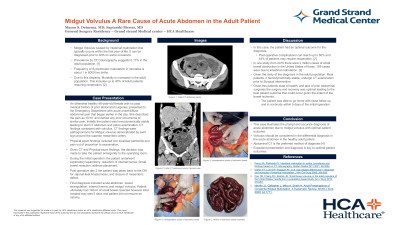General Surgery
Category: Quickshot Oral Session 25
Quickshot Oral : Quickshot Oral Session 25
MIDGUT VOLVULUS A RARE CAUSE OF ACUTE ABDOMEN IN THE ADULT PATIENT
Tuesday, February 14, 2023
7:00am - 8:00am East Coast USA Time

- MD
Mason Deinema, MD
Resident
Grand Strand Medical Center, United States - MD
Mason Deinema, MD
Resident
Grand Strand Medical Center, United States
Presenter(s)
Principal Contact(s)
Objectives: Symptomatic bowel malrotation first presenting in the adult is rare. Typically, malrotation will first present in childhood resulting operative fixation. CT imaging plays an important role in diagnosis and can be crucial to rapid diagnosis and operative planning. The swirling pattern on imaging around the superior mesenteric artery is diagnostic if seen. We are presenting a case of acute abdomen caused by bowel malrotation complicated by midgut volvulus in an adult patient whose CT imaging was pathognomonic.
Methods: An otherwise healthy 48-year-old female with no past medical history of prior abdominal surgeries who presented to the Emergency department with an acute abdomen. She underwent CT, with findings consistent with midgut volvulus. On initial examination patient presented with acute onset abdominal pain out of proportion to exam. Initially the patient was hemodynamically stable leading to CT abdomen and pelvis examination. CT findings were pathognomonic for Midgut volvulus demonstrated by swirl sign around the superior mesenteric artery. Final diagnosis included midgut volvulus, internal herniation causing bowel strangulation. Patient ultimately underwent exploratory laparotomy with 140cm of small bowel resected, re-anastomosis prior to discharge.
Results: The diagnosis of Midgut volvulus is typically made within the first month of life. To present as an acute abdomen in the adult patient is rare however should not be excluded from a differential in the adult patient. The treatment is surgical and in this patient’s case, extensive resection of small bowel due to bowel strangulation.
Conclusion: This case illustrates the prompt and accurate diagnosis of acute abdomen due to midgut volvulus with optimal patient outcome.
Methods: An otherwise healthy 48-year-old female with no past medical history of prior abdominal surgeries who presented to the Emergency department with an acute abdomen. She underwent CT, with findings consistent with midgut volvulus. On initial examination patient presented with acute onset abdominal pain out of proportion to exam. Initially the patient was hemodynamically stable leading to CT abdomen and pelvis examination. CT findings were pathognomonic for Midgut volvulus demonstrated by swirl sign around the superior mesenteric artery. Final diagnosis included midgut volvulus, internal herniation causing bowel strangulation. Patient ultimately underwent exploratory laparotomy with 140cm of small bowel resected, re-anastomosis prior to discharge.
Results: The diagnosis of Midgut volvulus is typically made within the first month of life. To present as an acute abdomen in the adult patient is rare however should not be excluded from a differential in the adult patient. The treatment is surgical and in this patient’s case, extensive resection of small bowel due to bowel strangulation.
Conclusion: This case illustrates the prompt and accurate diagnosis of acute abdomen due to midgut volvulus with optimal patient outcome.

